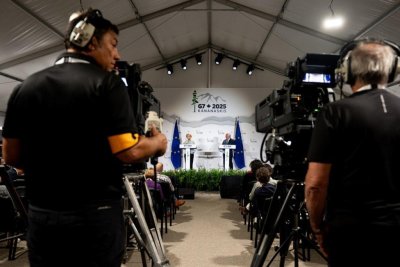
President of the European Commission Ursula von der Leyen (L) and President of the European Council António Costa participate in a press conference during the G7 Leaders’ Summit in Kananaskis, Alberta, Canada, on Monday. Photo by Spencer Colby/EPA-EFE
June 16 (UPI) — U.S. President Donald Trump participated in a meeting of the G7 in Canada on Monday that had a wide range of pressing issues including the Israel-Iran conflict and trade
He and counterparts from Europe and Japan, as well as six countries not in the group that were invited to attend, will meet for three days.
Ahead of the summit in Kananaskis, Alberta, Trump held a bilateral meeting with Canadian Prime Minister Mark Carney, their second in less than six weeks after the U.S. president hosted Carney in the White House after his unexpected general election victory April 28, attributed in large part due to “the Trump effect.”
Trump had said he expected to ink new trade agreements at the meetings, which are also being attended by the European Union, Ukraine, Mexico, South Korea, South Africa, India and Australia, but ABC News said Israel’s strikes on Iran had “scrambled” the agenda.
The network said there were differences between the U.S. administration and its international allies, with Trump telling ABC he was open to an offer from Russian President Vladimir Putin to mediate between the parties.
French President Emmanuel rejected the idea, saying Putin lacked the necessary credibility due to his country’s military intervention in Ukraine.
The president held a roughly 60-minute call with Putin in recent days in which much of the focus was on the Israel-Iran fighting, and less on Ukraine. However, Trump was scheduled to hold a one-on-one meeting with Ukrainian President Volodymyr Zelensky during the summit.
Uncertainty generated by Trump’s positions on the big geopolitical issues was likely seen as forcing allies to seek reassurance on where he stands, from supporting Ukraine over the longer term to what to do about Iran, as well as looming fears of a global trade war.
Trump is expected to hold a series of bilateral meetings with the key trading partners at the summit, many of them slapped by the United States with hefty goods tariffs and separate tariffs on autos and steel and aluminum. Some have responded in kind.
Canada is among the countries hardest hit, with a 25% tariff on autos imported into the United and 50% on steel and aluminum. Canada also faces tariffs, along with Mexico on imports of goods not exempted by the United States-Mexico-Canada Agreement.
Trump told reporters as he departed for Canada that deals with the United States’ trading partners were just a matter of formally notifying them “what you’re going to have to pay,” but the summit comes amid Trump’s 90-day pause on “reciprocal” tariffs announced May 12.
The EU, in particular, wants to get a deal done before the July 9 expiration of a 10% tariff reduction implemented by Trump to allow time for negotiations.
So far, the only country with which a deal has been reached, but not implemented, is Britain. That deal announced in May allows Britain to export 100,000 cars annually to the United States at its standard 10% baseline tariff rate.
The deal also allows for British steel and aluminum quotas that will effectively reduce the tariffs to zero, although it currently remains at 25%, but still far below the 50% imposed on all other countries.
Trump is making his first appearance at the summit since attending a meeting in the south of France in 2019. The previous year’s gathering in Canada ended with him withdrawing support for the final communique.